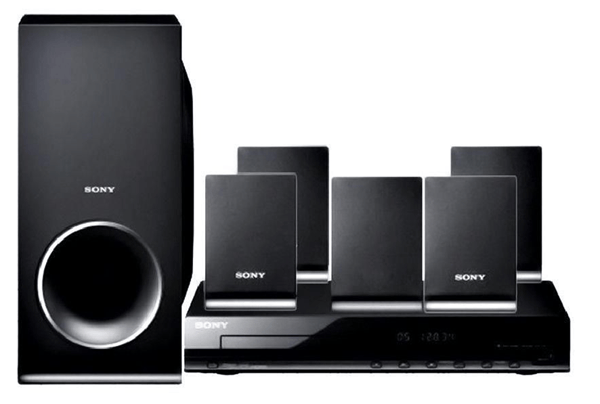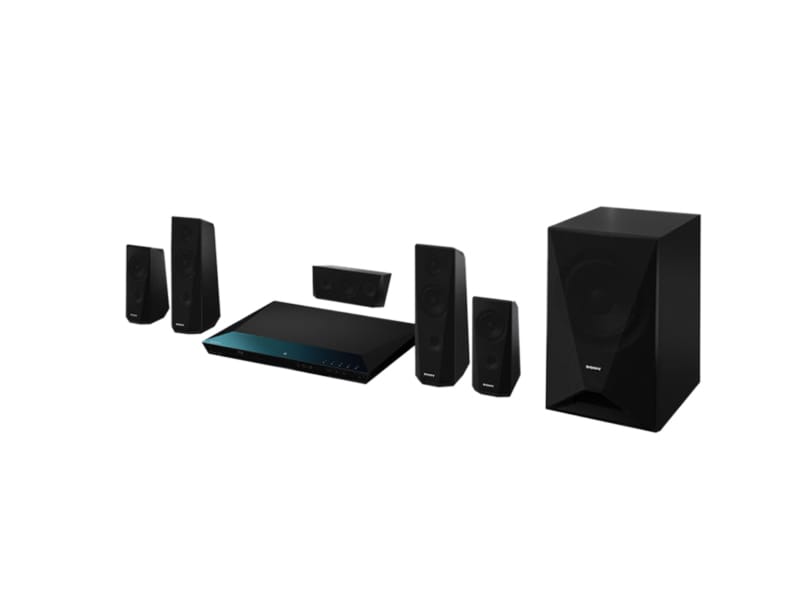More Firestick with older equipment

Hi Chris, I’m in Nairobi, Kenya. I recently bought an Amazon firestick to help “transform” my basic Samsung UHD (Model PA51H4500AR) tv to something much more exciting. I think I am only halfway there as I was disappointed to note that the firestick does not work with my Sony DAV-TZ140 home theater. I ran to the internet for a solution and stumbled across an article you wrote in 2016. Although the article was really insightful, I was hoping you could offer a personal solution to my problem. The tv has two HDMI ports, an optical audio port but it is just my luck that the home theater does not. If I will need a receiver, I would be grateful if you could point me to one I can purchase. Thanks!
A quick google search on your home theater system (using search terms “Sony DAV-TZ140 manual”) yielded an online manual which I used to check what sort of audio inputs you have. It only shows 2-channel analog stereo inputs (using RCA plugs), so there’s likely no way to get full surround sound from the Firestick to the system’s speakers.

You could use an HDMI audio extractor box such as this one for £18UK. I’m giving you Amazon UK links since Kenya uses the same type of electrical power (type G plugs, 240v 50hz). With that and a simple RCA stereo audio cable, you can at least get stereo audio from the Firestick to the surround sound speakers. Here’s how you’d connect things:
- Run an HDMI cable from the extractor box’s HDMI OUT port to an available HDMI IN port on the TV. Don’t forget to provide electrical power to the extractor box (you may need a converter if you buy the extractor box from overseas).
- Connect the RCA stereo audio cable between the extractor box’s RCA OUT ports and the matching RCA IN ports on the back of your home theater.
- Turn on the TV and set it to use the HDMI port coming from the extractor box. Also turn on the Sony DAV-TZ140 and set it to use the Audio In source (button #5 on the remote control). See page 14 of the manual.

Once all that’s done, you can connect the Firestick to the extractor box’s HDMI in port. Don’t forget to provide electrical power to the Firestick (using the microUSB port on the side of the Firestick). At that point, the extractor box should validate HD Copyright Protection (HDCP) with the Firestick and allow the video to play through to the TV, and send the stereo audio to the Sony DAV-TX140. You want to make sure that everything else is connected and setup correctly before you connect the Firestick, so that the Firestick’s HDCP circuitry can ‘see’ all the other connected equipment. Firesticks can be finicky about HDCP.
Of course, you almost certainly won’t get beautiful 5.1 channel surround sound which the Firestick is perfectly capable of providing. Your home theater system wasn’t designed for general purpose home theater work. It was only designed to play DVDs and send that surround sound audio to the speakers. I can’t tell for sure from the online manual, but your receiver does have Dolby ProLogic circuitry, so it should be able to take the 2-channel audio signal from the extractor box and split the signal to all your surround sound speakers, ‘faking’ surround sound. To cycle through the audio capabilities, press the Surround button on your remote repeatedly while playing a movie and choose the setting that sounds the best (probably the MULTI or A.F. MULTI entry on the receiver).

If you want a true home theater experience with true 5.1 channel audio from the Firestick, you’ll need a more capable home theater receiver. I can’t guarantee how well those Sony surround sound speakers will work with a different system, so you might need a set of generic home theater surround sound speakers, or a new home theater receiver that comes with a set of matched speakers. After all, your current system and those speakers are only rated for 30 watts.
Without knowing your budget and what home theater stores are available in your area, my suggestion would be for you to shop around and see what’s available.
This website runs on a patronage model. If you find my answers of value, please consider supporting me by sending any dollar amount via:
or by mailing a check/cash to PosiTek.net LLC 1934 Old Gallows Road, Suite 350, Tysons Corner VA 22182. I am not a non-profit, but your support helps me to continue delivering advice and consumer technology support to the public. Thanks!








Hi Chris,
Thanks for all the feedback on your site.
I was hoping you could help me as I am having trouble letting go of my old receiver and large Pinnacle speakers. The receiver is hard wired to ceiling/floor speakers. Watched a DVD last night (with receiver sound) and would love to have this sound with the Fire stick too. Is there a good, cheap way of making this happen? Or am at the stage where I need to have a modern receiver or other set-up?
Receiver: Pioneer VSX-1019AH (housing in a low cabinet w/front windows; not close to router)
TV: LG Nano 9 series –2020 (65NANO90UNA)
Fire stick” 2020 4k
thanks, greg
Hi Greg, happy to help!
I looked up your Pioneer receiver: the online manual for the VSX-1019AH-K is at https://www.pioneerelectronics.com/StaticFiles/Manuals/Home/VSX-1019AH-K_OperatingInstructions0128.pdf. If you have that model, it has multiple HDMI IN ports and you can plug the Firestick into an available HDMI IN port. I’m assuming you have:
1. connected an HDMI cable from the Pioneer’s HDMI OUT port to one of the LG TV’s HDM IN ports and set the TV to use that HDMI IN port.
2. connected the Firestick to one of the Pioneer’s HDMI IN ports after you had already turned on the TV and set the Pioneer to use the HDMI IN port used for the Firestick
You want to make sure the the Firestick runs HD Copyright Protection (HDCP) and authorizes your TV to play the video from the Firestick. hence the order of connection above. Once you’ve done all this, you should be able to stream content from the Firestick without issue – HD video to the TV and Dolby Digital audio to the Pioneer-connected speakers.
I see only two potential issues:
1. If you want to watch 4k video. Your Firestick and TV are 4k compatible (3840×2160), but your Pioneer receiver is only HD compatible (1920×1080). The Pioneer receiver won’t up-convert the video to 4k.
2. If the distance from router to home theatre equipment is too far and you can’t get a WiFi signal to the cabinet.
For problem #1, you could plug the Firestick directly into an HDMI IN port on the TV, and run an optical cable from the TV to the Pioneer receiver for audio. That’s if your particular TV has an Optical OUT port (it’s not clear from the online manuals). Then you’d watch 4k video on the TV, and send Dolby Digital audio out via the optical cable to the Pioneer and onto the speakers.
For problem #2, you’ll need a way to get WiFi signal to the Firestick as that’s the only way it connects to the internet for streaming video.
I used the manual for your LG TV at https://www.lg.com/us/support/product/lg-65NANO90UNA.AUS for reference – so I assume you are in Australia, right?
You may want to refer to my article at https://positek.net/hdcp-explained/ if you are having trouble getting the Firestick to send video to the TV and audio to the speakers. Firesticks are quite finicky about HDCP.
Wow, Chris, thanks for such a detailed and quick response. VERY much appreciated! greg
Hi Chris. I have a Philips hts home theatre system, a 4K firestick and a samsung ue42f5000ak. The home cinema works fine on the tv but when I change input for the firestick which is in the tv usb it doesn’t. Not sure how to get round this as have looked at youtube.
Thankyou
Gary (UK)
Hi Chris. Sorry but the Philips hts is hts3357
Thanks
Gary(UK)
Hi Gary, the online manual for the Philips receiver is at https://www.download.p4c.philips.com/files/h/hts3357_05/hts3357_05_dfu_eng.pdf and online online help for the Samsung TV is at https://www.samsung.com/uk/support/model/UE42F5000AKXRU/#downloads. I’m using these as the source for my advice.
You say the Firestick is in the “tv usb”. I’m assuming you meant to say that the Firestick’s HDMI OUT plug is plugged into a available HDMI IN port on the TV. If you have the Firestick’s microUSB cable plugged into a USB port on the TV, that’s likely not providing the electrical power needed by the Firestick – the Firestick’s USB power should always be connected to the included USB wall power adapter to get enough power.
If you’re not getting video from the Firestick to the TV, that may be the primary issue. This of course doesn’t address the audio part of the Firestick, so read on…
Your Philips “receiver” isn’t equipped to handle multiple HDMI inputs, which is what you’d need to plug the Firestick into it. Since the Firestick is plugged into an HDMI port on the TV (I’m assuming), there’s no way for audio signal to get to the speakers attached to the Philips receiver.
Your Philips receiver does have a coaxial digital audio IN port (see page 18 of the manual). Your TV (see the 2-page installation guide) only has an optical digital audio OUT port. So you can’t connect the TV to the receiver for audio.
Your simplest solution is to get an HDMI audio extractor box with HDMI IN/OUT that goes in-between the Firestick and TV, and with a coaxial digital audio OUT port that connects to the coaxial digital audio IN port on the Philips receiver. Along with plugging the Firestick’s microUSB into the wall outlet/power adapter, you can then get video on the TV and digital surround-sound audio to the Philps’ speakers.
Such as this one for £20.99: https://www.amazon.co.uk/Extractor-Converter-Optical-Coaxial-Support-Black/dp/B088T8F7MJ along with a coaxial cable such as this one for £4.85: https://www.amazon.co.uk/AmazonBasics-Digital-Audio-Coaxial-Cable-Black/dp/B01D5H8TS4
Remember that digital signals are protected with HDCP (copyright protection circuitry), so as you connect things, you need to make sure the Firestick can ‘see’ the other components as they are connected, so all the devices in your system can be verified. That means:
1. connect the extractor box HDMI OUT to the TV. Turn on the TV and set it to use the HDMI port where you connected the extractor box. Also provide electrical power to the extractor box.
2. connect the coaxial cable from the extractor box’s coaxial OUT port to the Philips receiver’s coaxial IN port. Turn on the Philips receiver and set it to use the input source for the coaxial IN port.
3. connect the Firestick’s USB power and plug the Firestick’s HDMI OUT into the extractor box’s HDMI IN port. The Firestick will validate the extractor box, the TV and the receiver and let you see and hear digital content.
That should do it for you.